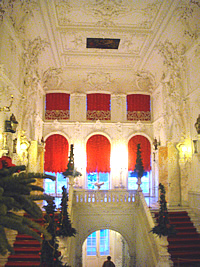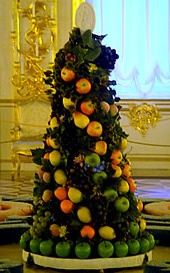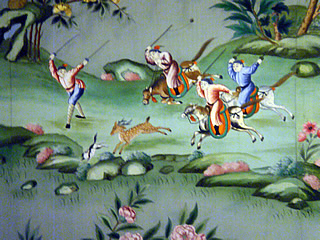


A day trip from St Petersburg, primarily to see the magnificent Amber Room in the Catherine Palace, a fabulously gilded imperial residence.


We took a taxi from St Petersburg to Tsarskoye Selo, it seemed the best choice, otherwise it was metro and bus and everything tends to be in Russian!
It took about an hour but it was an easy journey. The drivers are fast but seem to be safe - not too many dented cars!

The huge Catherine Palace is fabulous: blue and white and gold domes and gilded gates. Inside tons of gilding, very opulent, and the celebrated Amber Room.


The palace was named after the wife of Peter the Great. Though a palace has stood here since the early eighteenth century, it was in the latter half of the century that the baroque palace as it stands today was created to the designs of Bartolomeo Francesco Rastrelli, the chief architect of the Imperial court.

Under Empress Catherine II the Scottish architect Charles Cameron designed some interiors inspired by ancient architecture and rooms devoted to victories of the Russian army were celebrated in rooms designed by Vasily Stasov. The palace website has a lot of information about the history and individual rooms.1

A huge fire in 1820 did much damage necessitating the restoration of many rooms. The palace and park were turned into a museum after the October revolution in 1917.


Up the main staircase and through to the Great Hall and I don't think I've seen as much gilding in a room anywhere that can compete with this. If it stuck out from the wall it was gilded - and there's a lot sticking out from the walls!!










Official receptions as well as balls and banquets, were held in the Great Hall. Guests would first be taken to antechambers before entering. Again these have lots of gilding plus two of Rastrelli's magnificent blue and white ceramic heating stoves.




Back through the Great Hall is the Chevaliers' Dining Room and the White State Dining Room, both with more baroque/rococo gilding and mirrored walls and magnificent stoves.



The spectacular highlight of the palace is the celebrated Amber Room. No photographs are allowed within the room and guards watch everyone with hawk eyes!
When Russia and Prussia became allies in 1716, among the gifts given by the King of Prussia was the Amber Study, which Tsar Peter the Great had "long desired".2
This masterpiece of German craftsmanship was installed in the Winter Palace but in 1755 Empress Elizabeth asked Rastrelli to design a new room in the Catherine Palace to accommodate the amber panels. The panels are composed of fabulous amber mosaic patterns, images and carved amber decoration. The stone varies in colour from pale yellow to a deep, rich red.
The original amber panels were looted by the Nazis during the Second World War. Though many treasures were removed from the palace for safe-keeping, the amber was too brittle. In an attempt to hide the panels from the invaders the room was papered to cover them over, but this failed to keep them secret and they were removed and shipped to Königsberg Castle in Germany. In 1944, during the German retreat, the panels were again removed and transported but from this time there is no record of what happened to the amber.
In 1979 it was decided to recreate the Amber Room, with financial aid from a German company. A Russian-made marquetry chest-of-drawers and the Florentine mosaic Touch and Smell, elements of the original room that had been found in Germany, were returned to be incorporated in the room.

The following Picture Hall completes the set of state rooms which became known as the Golden Enfilade, renowned for their magnificence. from here we were seeing mostly personal rooms of the family rather than public state rooms.

I particularly liked the Chinese-style painted silk-lined walls in the Chinese Dining room. I did not like at all the Green Dining Room inspired by ancient villa decoration created by Cameron! His State Blue Drawing Room, with silk-lined walls in blue and white, is better.

What a lot of dining rooms there are in this place!




The walls of the Chinese Blue Drawing were lined with beautiful blue Chinese silks painted with scenes and landscapes.
This part of the palace has several rooms which were used by Tsar Alexander Ist, favourite grandson of Catherine II, which have been preserved and, like many rooms, restored after the 1820 fire.
During the Napoleonic wars Alexander often rode into battle himself, crossing into France in 1814. His campaign bed and sword are kept in the Memorial Rooms of Emperor Alexander I.


Catherine II gave this palace to Alexander I as a wedding present, though all his life he preferred the rooms of his youth in the Catherine Palace. The two palaces are very close, just a short walk through the small town of Tsarskoye Selo, also known as Pushkin after the poet who was educated at the Tsarskoye Selo Lyceum.



The Alexander Palace3 was a summer dacha for the Imperial family but became the home of Tsar Nicholas II. It was from here that he and his family were exiled to Tobolsk.
We again were able to wander around on our own - unlike the Catherine Palace there was no-one else here!
The family rooms of Nicholas II were really quite domestic. He had a beautiful study cum billiard room, spacious but cosy with a snug corner fitted with a fire and built-in seating.


We had an impression that there was more to see but nobody spoke English and our Russian was nonexistent. We eventually paid an extra 100 roubles each and were directed upstairs to an exhibition on the Romanov family which didn't delay us for very long.

We retrieved our coats from the cloakroom - everywhere seems to have a cloakroom - and made our way to the central block of the palace where we paid another fee and were shown (after again donning overshoes) into a large white state room, with a semi-circular external wall, which is situated beneath the central dome of the building. On either side this led through columned arches to a Portrait Hall and the Marble Drawing Room. These were state rooms and designed to impress, the Semi-CIrcular Hall being the centre of the suite of rooms.
By this time we had had our fill of palaces so went back into the town to find some place to eat. We stumbled upon XIX Restaurant and had a good meal there - the pork in a sesame seed coating with a pomegranate sauce and garlicky rustic potatoes was superb! Again we left our coats in a cloakroom manned by a very nice old man. The restaurant seemed to have a number of rooms, the one we were in had a very hobbit-like interior.
Efficiently picked up by our taxi outside the restaurant and back to St. Petersburg.